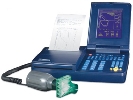
ACOEM Publishes Updated Spirometry Guidance
Developed by the college's Occupational and Environmental Lung Disorders Committee, the guidance statement is available as a free online article from the May issue of JOEM, the Journal of Occupational and Environmental Medicine.
A detailed guidance statement developed by the American College of Occupational and Environmental Medicine's Occupational and Environmental Lung Disorders Committee updates previous ACOEM guidance on spirometry, the lung function tests that help to prevent occupational respiratory diseases. The 2011 guidance statement is available as a free online article from the May issue of JOEM, the Journal of Occupational and Environmental Medicine (Vol. 53, Issue 5, pp. 569-584), and was created for four reasons, according to the statement:
- The American Thoracic Society and the European Respiratory Society issued a series of joint official statements on standardization of lung function testing.
- The International Organization for Standardization issued the ISO 26782 standard covering essential technical operating characteristics of spirometers.
- Spirometry errors caused by improper use of some flow-type spirometers have been documented and published.
- More attention is being paid to how lung function changes over time are interpreted.
The statement strongly recommends that spirometers used for occupational spirometry tests provide: (1) a real-time display of both flow-volume and volume-time curves which meets or exceeds ATS/ERS minimum size and ISO minimum aspect ratio standards; (2) graphs in hard-copy printouts that meet or exceed ATS/ERS minimum size standards; and (3) standard electronic spirometer output of results and curves. Such spirometers also should: (1) save all information from up to eight maneuvers in a subject test session; (2) permit later editing and deletion of earlier flawed test results; (3) provide a complete spirometry test report for review of technical quality, which includes all flow-volume and volume-time curves, and test results from at least the three best maneuvers and preferably from all saved efforts; (4) optionally provide a separate final spirometry summary report for interpretation of the best test results; (5) provide computer-derived technical quality indicators; (6) provide a dedicated routine for verifying spirometer calibration; and (7) save indefinitely a comprehensive electronic record of all calibration and calibration verification results.
The statement also strongly recommends that all technicians conducting occupational spirometry tests successfully complete an initial NIOSH-approved spirometry course and NIOSH-approved refresher courses every five years.
The committee's members are lead author Mary Townsend, DrPH; William Eschenbacher, M.D., chair; William Beckett, M.D.; Bruce Bohnker, M.D.; Carl Brodkin, M.D.; Clayton Cowl, M.D.; Tee Guidotti, M.D.; Athena Jolly, M.D.; Francesca Litow, M.D.; James Lockey, M.D.; Edward Petsonk, M.D.; Larry Raymond, M.D.; Paul Scanlon, M.D.; Thomas Truncale, M.D.; and Stephen Wintermeyer, M.D.